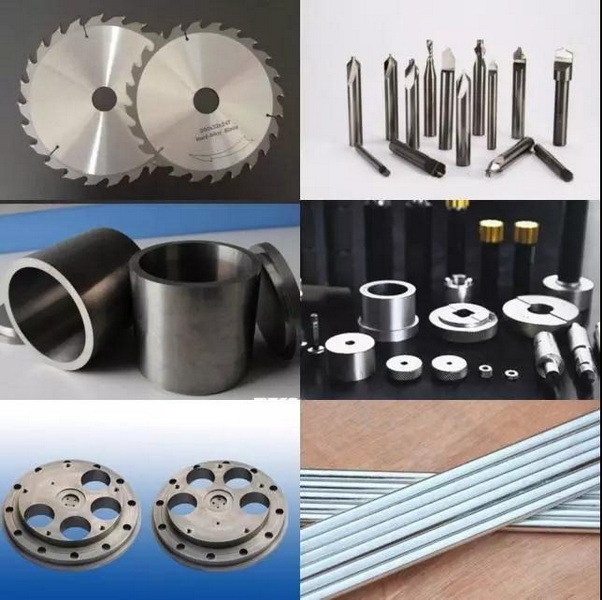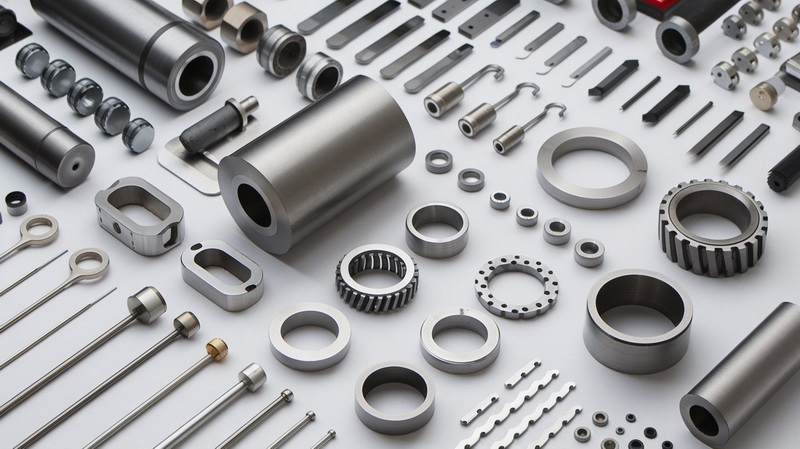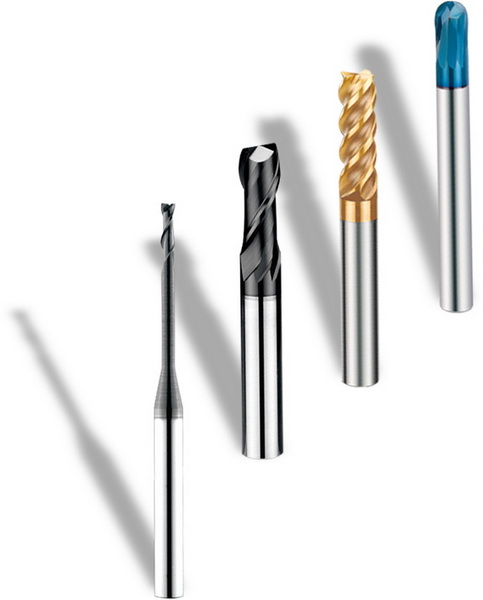Content Menu
● Introduction to Tungsten Carbide
● How Hard Is Tungsten Carbide?
>> Mohs Hardness Scale
● Materials Harder Than Tungsten Carbide
>> 1. Diamond
>> 2. Cubic Boron Nitride (cBN)
>> 3. Boron Carbide
>> 4. Other Superhard Materials
● Comparative Hardness Table
● Why Is Tungsten Carbide So Hard?
>> Factors Affecting Hardness
● The Science of Hardness: Measuring and Understanding
>> Types of Hardness Tests
>> Hardness vs. Toughness
● Applications of Tungsten Carbide and Harder Materials
>> Tungsten Carbide
>> Diamond
>> Cubic Boron Nitride
>> Boron Carbide
● Limitations and Trade-offs
>> The Balance in Engineering
● Recent Advances in Superhard Materials
>> Wurtzite Boron Nitride
>> Aggregated Diamond Nanorods
>> Rhenium Diboride
● Conclusion
● FAQ: Frequently Asked Questions
>> 1. What is the Mohs hardness of tungsten carbide?
>> 2. Is anything harder than tungsten carbide?
>> 3. Why isn't diamond used for all cutting tools if it's the hardest?
>> 4. How does cubic boron nitride compare to tungsten carbide?
>> 5. What factors affect the hardness of tungsten carbide?
● Citations:
Tungsten carbide is celebrated across industries for its exceptional hardness, durability, and resistance to wear. But is anything harder than tungsten carbide? This comprehensive article explores the science of hardness, compares tungsten carbide to other superhard materials, and explains where each material excels. Along the way, you'll find illustrative diagrams and tables to help visualize these concepts.

Introduction to Tungsten Carbide
Tungsten carbide (WC) is a chemical compound composed of equal parts tungsten and carbon atoms. In its basic form, it is a fine gray powder, but it is often pressed and sintered into solid shapes for use in tools and machinery. Its unique combination of hardness, toughness, and resistance to wear makes it indispensable in industries ranging from mining to manufacturing.
How Hard Is Tungsten Carbide?
Mohs Hardness Scale
The Mohs scale ranks minerals by their ability to scratch one another, from 1 (talc) to 10 (diamond).
- Tungsten carbide: 9–9.5 on the Mohs scale.
- Vickers Hardness: 2400–3000 HV.
- Rockwell Hardness (HRA): 89–95 HRA (approx. 69–81 HRC).
This places tungsten carbide just below diamond, the hardest known natural material.
Materials Harder Than Tungsten Carbide
Despite its impressive hardness, several materials surpass tungsten carbide:
1. Diamond
- Mohs Hardness: 10
- Vickers Hardness: Up to 10,000 HV
- Description: The hardest known natural material, composed of carbon atoms in a tetrahedral lattice.
- Applications: Cutting, grinding, drilling, jewelry.
2. Cubic Boron Nitride (cBN)
- Mohs Hardness: 9.5–10
- Vickers Hardness: Up to 4800 HV
- Description: Synthetic material, second only to diamond in hardness, but with better chemical stability at high temperatures.
- Applications: Cutting tools for hardened steels, abrasives.
3. Boron Carbide
- Mohs Hardness: 9.5
- Vickers Hardness: 2900–3800 HV
- Description: Extremely hard ceramic, third hardest known material.
- Applications: Armor, abrasives, neutron absorber.
4. Other Superhard Materials
- Rhenium Diboride (ReB₂): Synthetic, Mohs ~9.5
- Wurtzite Boron Nitride: Synthetic, potentially harder than diamond under certain conditions.
Comparative Hardness Table
| Material | Mohs Hardness | Vickers Hardness (HV) | Typical Use Cases |
| Diamond | 10 | up to 10,000 | Cutting, abrasives, jewelry |
| Cubic Boron Nitride | 9.5–10 | up to 4800 | Cutting hardened steel, abrasives |
| Boron Carbide | 9.5 | 2900–3800 | Armor, abrasives, nuclear applications |
| Tungsten Carbide | 9–9.5 | 2400–3000 | Cutting tools, mining, wear parts |
| Alumina (Al₂O₃) | 9 | 1200–1800 | Ceramics, electrical insulators |
| Hardened Steel | 7–8.5 | 800–900 | Tools, machine parts |
Why Is Tungsten Carbide So Hard?
Tungsten carbide's hardness is a result of its unique atomic structure:
- Crystal Structure: Hexagonal close-packed (HCP) lattice.
- Bonding: Strong covalent bonds between tungsten and carbon atoms form a rigid, stable lattice that resists deformation.
- Density: High density (15.6 g/cm³), contributing to its robustness.
Factors Affecting Hardness
- Grain Size: Finer grains increase hardness but reduce toughness.
- Binder Content: Lower cobalt binder increases hardness but can make the material more brittle.
- Sintering Process: Higher temperatures and optimized times improve density and hardness.
The Science of Hardness: Measuring and Understanding
Hardness is a complex property that can be measured in several ways. It generally refers to a material's resistance to deformation, scratching, or indentation.
Types of Hardness Tests
- Mohs Hardness: Qualitative, based on scratch resistance.
- Vickers Hardness: Quantitative, measures the size of an indentation left by a diamond pyramid under a known force.
- Rockwell Hardness: Measures depth of penetration under load.
Each test provides different insights. For industrial applications, Vickers and Rockwell are more precise and repeatable than Mohs.
Hardness vs. Toughness
It's important to distinguish between hardness and toughness. Hardness is resistance to scratching or indentation, while toughness is the ability to absorb energy and resist fracturing. For example, glass is hard but not tough—it shatters easily. Tungsten carbide balances high hardness with useful toughness, making it more practical than diamond for many applications.

Applications of Tungsten Carbide and Harder Materials
Tungsten Carbide
- Cutting tools: Drill bits, end mills, saw blades.
- Mining: Drill tips, crusher plates.
- Industrial machinery: Nozzles, valves, wear-resistant parts.
- Jewelry: Rings, watch bands due to scratch resistance.
Diamond
- Industrial cutting and grinding: Diamond-tipped saws and grinding wheels.
- Abrasives: Polishing and lapping.
- Electronics: Heat sinks, semiconductors.
Cubic Boron Nitride
- Machining hardened steels: Cutting tools for automotive and aerospace industries.
- Abrasives: Grinding wheels for precision machining.
Boron Carbide
- Body armor: Lightweight, bullet-resistant vests.
- Abrasives: Lapping and polishing hard materials.
- Nuclear industry: Neutron absorber rods.
Limitations and Trade-offs
While hardness is valuable, ultra-hard materials often have trade-offs:
- Brittleness: Harder materials like diamond and cBN can be more brittle than tungsten carbide, making them prone to chipping under impact.
- Cost: Diamond and cBN are significantly more expensive to produce than tungsten carbide.
- Machinability: Ultra-hard materials are difficult to shape and finish, often requiring specialized equipment.
- Thermal Stability: Diamond, while extremely hard, reacts with iron at high temperatures, limiting its use in steel machining.
The Balance in Engineering
Engineers must balance hardness with toughness, cost, and other properties. For example, tungsten carbide is often chosen for its combination of hardness and toughness, while diamond is reserved for applications where maximum hardness is essential and cost is justified.
Recent Advances in Superhard Materials
Material science continues to push the boundaries of hardness. Recent research has produced new synthetic materials that rival or even surpass diamond under certain conditions.
Wurtzite Boron Nitride
- Structure: Similar to diamond but with boron and nitrogen atoms.
- Potential: Under extreme pressure, wurtzite boron nitride may exceed diamond's hardness.
- Applications: Still largely experimental, but promising for future cutting and abrasive tools.
Aggregated Diamond Nanorods
- Description: Synthetic nanocrystalline diamonds with a hardness greater than natural diamond.
- Significance: These materials are produced under extreme pressures and have unique properties, such as higher indentation resistance.
Rhenium Diboride
- Discovery: First synthesized in the early 2000s.
- Properties: Hardness close to cBN, with superior machinability compared to diamond.
- Potential Uses: High-wear coatings and cutting tools.
These advances may one day lead to new generations of tools and components that outperform current materials in terms of hardness and durability.
Conclusion
Tungsten carbide stands as one of the hardest engineered materials, with a Mohs hardness of 9–9.5, making it invaluable for applications requiring extreme wear resistance and durability. However, several materials—most notably diamond, cubic boron nitride, and boron carbide—are even harder. Each of these materials finds its niche, balancing hardness, toughness, cost, and other properties for specific industrial needs.
Understanding the hierarchy of material hardness is essential for selecting the right tool or component for demanding environments. As material science advances, we continue to discover and engineer substances that push the boundaries of what is possible in terms of hardness and performance.

FAQ: Frequently Asked Questions
1. What is the Mohs hardness of tungsten carbide?
Tungsten carbide has a Mohs hardness of 9–9.5, placing it just below diamond and making it one of the hardest materials used in industry.
2. Is anything harder than tungsten carbide?
Yes. Diamond (Mohs 10), cubic boron nitride (Mohs 9.5–10), and boron carbide (Mohs 9.5) are all harder than tungsten carbide.
3. Why isn't diamond used for all cutting tools if it's the hardest?
Diamond is expensive, can be chemically reactive with iron at high temperatures, and is brittle. Tungsten carbide offers a better balance of hardness, toughness, and cost for many applications.
4. How does cubic boron nitride compare to tungsten carbide?
Cubic boron nitride is harder and more chemically stable at high temperatures, making it ideal for cutting hardened steels. However, it is more expensive and less tough than tungsten carbide.
5. What factors affect the hardness of tungsten carbide?
Grain size, binder content (typically cobalt), and sintering conditions all influence the hardness of tungsten carbide. Finer grains and lower binder content increase hardness but may reduce toughness.
Citations:
[1] https://konecarbide.com/tungsten-vs-tungsten-carbide-differences-explained/
[2] https://www.allied-material.co.jp/en/techinfo/tungsten_carbide/features.html
[3] https://shop.machinemfg.com/the-pros-and-cons-of-tungsten-carbide-a-comprehensive-guide/
[4] https://www.zhongbocarbide.com/what-is-the-hardness-of-tungsten-carbide.html
[5] https://www.zhongbocarbide.com/how-hard-is-tungsten-carbide-on-the-hardness-scale.html
[6] https://cowseal.com/tungsten-vs-tungsten-carbide/
[7] https://www.retopz.com/hardness-in-the-tungsten-carbide-industry-a-comprehensive-definition/
[8] https://www.zhongbocarbide.com/how-hard-is-tungsten-carbide-hrc.html
[9] https://www.carbide-part.com/blog/tungsten-carbide-hardness-vs-diamond/
[10] https://www.tungstenman.com/tungsten-carbide-hardness.html
[11] https://en.wikipedia.org/wiki/Tungsten_carbide
[12] https://va-tungsten.co.za/pure-tungsten-vs-tungsten-carbide-whats-the-difference/
[13] https://www.bladeforums.com/threads/carbide-hardness-chart.1705186/
[14] https://www.linde-amt.com/resource-library/articles/tungsten-carbide
[15] https://stock.adobe.com/search?k=tungsten+carbide
[16] http://www.nicrotec.com/welding-consumables/tungsten-carbide-alloys-nicrotec/products.html?c=1&g=13
[17] http://www.chinatungsten.com/cutting-tools/grades-and-performance/hardness-comparison-table.html
[18] https://www.retopz.com/57-frequently-asked-questions-faqs-about-tungsten-carbide/
[19] https://www.tungco.com/insights/blog/frequently-asked-questions-used-tungsten-carbide-inserts/
[20] https://carbosystem.com/en/tungsten-carbide/
[21] http://www.carbidetechnologies.com/faqs/
[22] https://cowseal.com/carbide-vs-steel/
[23] https://heegermaterials.com/blog/79_tungsten-carbide-vs-titanium-carbide.html
[24] https://carbideprocessors.com/pages/carbide-parts/tungsten-carbide-properties.html
[25] https://en.wikipedia.org/wiki/Tungsten_carbide
[26] https://www.bangerter.com/en/tungsten-carbide
[27] http://www.tungsten-carbide.com.cn
[28] https://cowseal.com/tungsten-vs-tungsten-carbide/
[29] https://www.mdpi.com/2075-4701/11/12/2035
[30] https://www.diva-portal.org/smash/get/diva2:1237216/FULLTEXT01.pdf
















